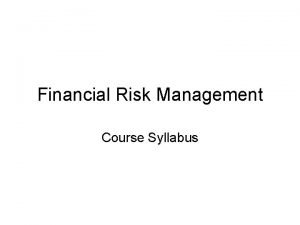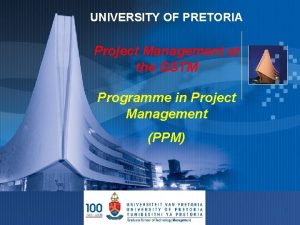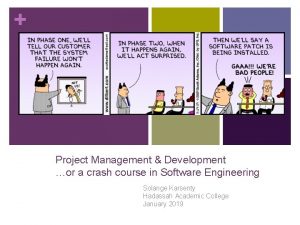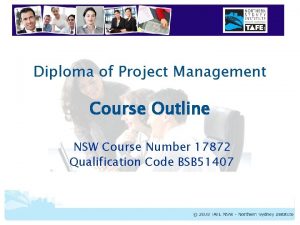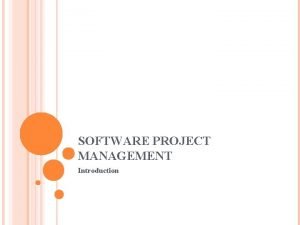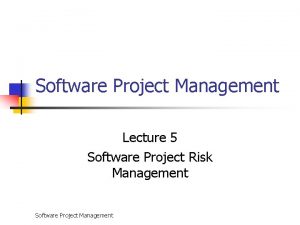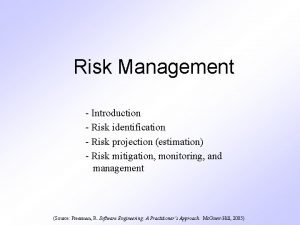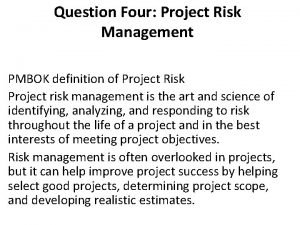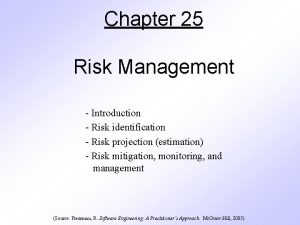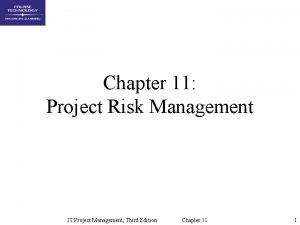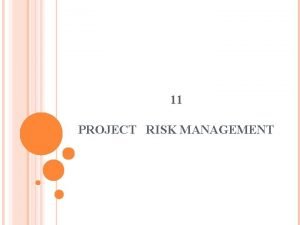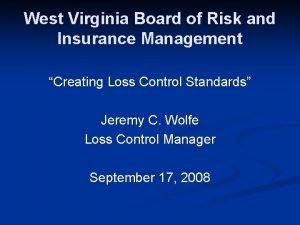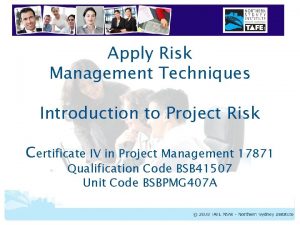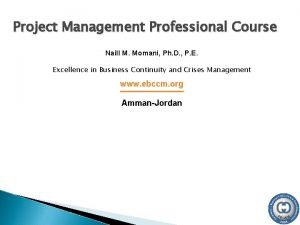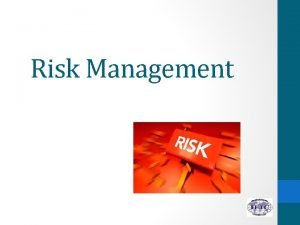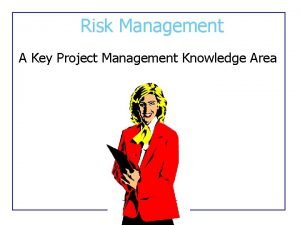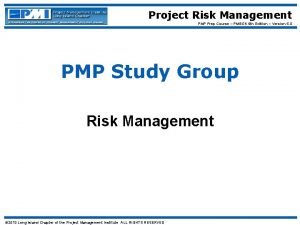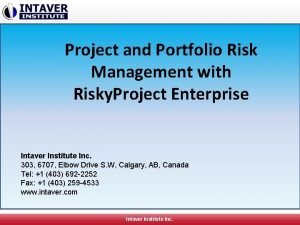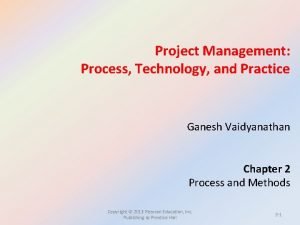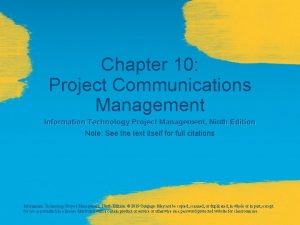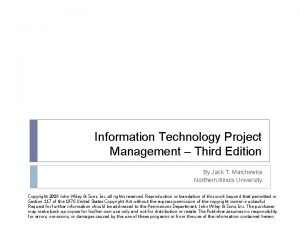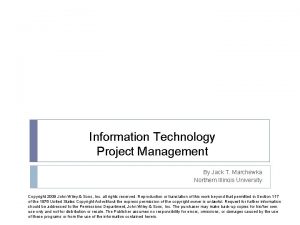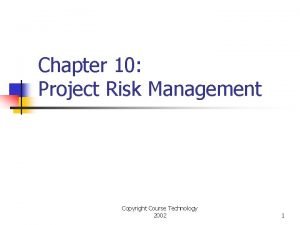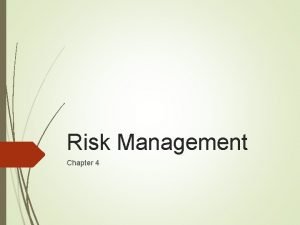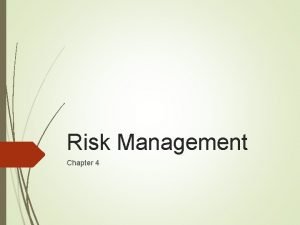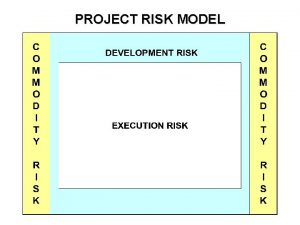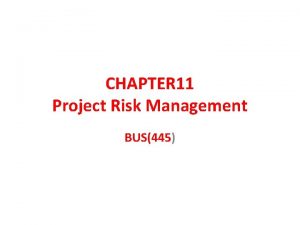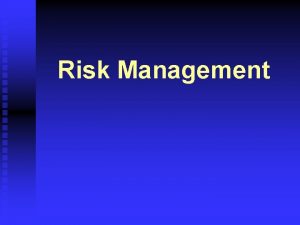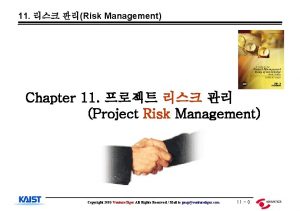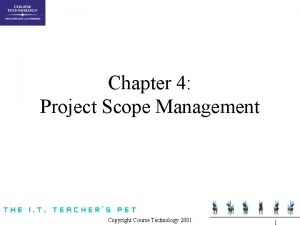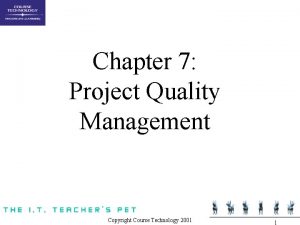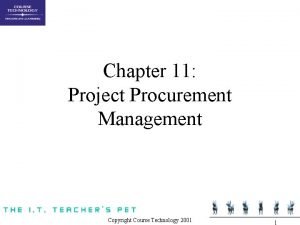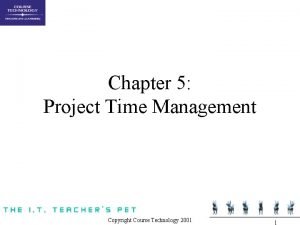Chapter 10 Project Risk Management Copyright Course Technology
































- Slides: 32

Chapter 10: Project Risk Management Copyright Course Technology 1999 1

The Importance of Project Risk Management l Project risk management is the art and science of identifying, assigning, and responding to risk throughout the life of a project and in the best interests of meeting project objectives l Risk management is often overlooked on projects, but it can help improve project success by helping select good projects, determining project scope, and developing realistic estimates Copyright Course Technology 1999 2

What is Risk? l A dictionary definition of risk is “the possibility of loss or injury” l Project risk involves understanding potential problems that might occur on the project and how they might impede project success l Risk management is like a form of insurance; it is an investment Copyright Course Technology 1999 3

Why Take Risks? Because of Opportunities! Try to balance risks and opportunities Risks Copyright Course Technology 1999 Opportunities 4

Risk Utility l Risk utility or risk tolerance is the amount of satisfaction or pleasure received from a potential payoff – Utility rises at a decreasing rate for a person who is risk-averse – Those who are risk-seeking have a higher tolerance for risk and their satisfaction increases when more payoff is at stake – The risk neutral approach achieves a balance between risk and payoff Copyright Course Technology 1999 5

Figure 10 -1. Risk Utility Function and Risk Preference Copyright Course Technology 1999 6

What is Project Risk Management? l The goal of project risk management is to minimize potential risks while maximizing potential opportunities. Major processes include – Risk identification: determining which risks are likely to affect a project – Risk quantification: evaluating risks to assess the range of possible project outcomes – Risk response development: taking steps to enhance opportunities and developing responses to threats – Risk response control: responding to risks over the course of the project Copyright Course Technology 1999 7

Common Sources of Risk on Information Technology Projects l Several studies show that IT projects share some common sources of risk l The Standish Group developed an IT success potential scoring sheet based on potential risks l Mc. Farlan developed a risk questionnaire to help assess risk l Other broad categories of risk help identify potential risks Copyright Course Technology 1999 8

Table 10 -1. Information Technology Success Potential Scoring Sheet Copyright Course Technology 1999 9

Table 10 -2. Mc. Farlan’s Risk Questionnaire Copyright Course Technology 1999 10

Market, Financial, and Technology Risk l Market risk: Will the new product be useful to the organization or marketable to others? Will users accept and use the product or service? l Financial risk: Can the organization afford to undertake the project? Is this project the best way to use the company’s financial resources? l Technology risk: Is the project technically feasible? Could the technology be obsolete before a useful product can be produced? Copyright Course Technology 1999 11

What Went Wrong? Several information technology projects fail because of technology risk. One project manager documented an important lesson he learned on a large IT project focus on business needs first, not technology. David Anderson, a project manager for Kaman Sciences Corp. , shared his lessons learned from a project failure in an article for CIO Enterprise Magazine. After spending two years and several hundred thousand dollars on a project to provide new client-server based financial and human resources information systems for their company, Anderson and his team finally admitted they had a failure on their hands. Anderson admitted that he was too enamored by using cutting edge technology and took a high-risk approach on the project. He "ramrodded through" what the project team was going to do, and he admitted that he was wrong. The company finally decided to switch to a more stable technology to meet the business needs of the company. Hildebrand, Carol. “If At First You Don’t Succeed, ” CIO Enterprise Magazine, April 15, 1998 Copyright Course Technology 1999 12

Risk Identification l Risk identification is the process of understanding what potential unsatisfactory outcomes are associated with a particular project l Several risk identification tools include checklists, flowcharts, and interviews Copyright Course Technology 1999 13

Table 10 -3. Potential Risk Conditions Associated With Each Knowledge Area Copyright Course Technology 1999 14

Risk Quantification l Risk quantification or risk analysis is the process of evaluating risks to asses the range of possible project outcomes l Determine the risk’s probability of occurrence and its impact to the project if the risk does occur l Risk quantification techniques include expected monetary value analysis, calculation of risk factors, PERT estimations, simulations, and expert judgment Copyright Course Technology 1999 15

Figure 10 -2. Expected Monetary Value (EMV) Example Copyright Course Technology 1999 16

Figure 10 -3. Chart Showing High-, Medium-, and Low-Risk Technologies Copyright Course Technology 1999 17

Simulation for Risk Analysis l Simulation uses a representation or model of a system to analyze the expected behavior or performance of the system l Monte Carlo analysis simulates a model’s outcome many time to provide a statistical distribution of the calculated results Copyright Course Technology 1999 18

What Went Right? Mc. Donnell Aircraft Company used Monte Carlo simulation to help quantify risks on several advanced-design engineering projects. The National Aerospace Plan (NASP) project involved many risks. The purpose of this multi-billion dollar project was to design and develop a vehicle that could fly into space using a single-stage-to-orbit approach. A single-stage-to-orbit approach meant the vehicle would have to achieve a speed of Mach 25 (25 times the speed of sound) without a rocket booster. A team of engineers and business professionals worked together in the mid-1980 s to develop a software model for estimating the time and cost of developing the NASP. This model was then linked with Monte Carlo simulation software to determine the sources of cost and schedule risk for the project. The results of the simulation were then used to determine how the company would invest its internal research and development funds. Although the NASP project was terminated, the resulting research has helped develop more advanced materials and propulsion systems used on many modern aircraft. Copyright Course Technology 1999 19

Expert Judgment l Many organizations rely on the intuitive feelings and past experience of experts to help identify potential project risks l The Delphi method is a technique for deriving a consensus among a panel of experts to make predictions about future developments Copyright Course Technology 1999 20

Risk Response Development l Risk avoidance: eliminating a specific threat or risk, usually by eliminating its causes l Risk acceptance: accepting the consequences should a risk occur l Risk mitigation: reducing th 4 e impact of a risk event by reducing the probability of its occurrence Copyright Course Technology 1999 21

Table 10 -4. General Risk Mitigation Strategies for Technical, Cost, and Schedule Risks Copyright Course Technology 1999 22

Risk Management Plans, Contingency Plans, and Contingency Reserves l A risk management plan documents the procedures for managing risk throughout the project l Contingency plans are predefined actions that the project team will take if an identified risk event occurs l Contingency reserves are provisions held by the project sponsor for possible changes in project scope or quality that can be used to mitigate cost and/or schedule risk Copyright Course Technology 1999 23

Table 10 -5. Questions Addressed in a Risk Management Plan l Why is it important to take/not take this risk in relation to the project objectives? l What specifically is the risk and what are the risk mitigation deliverables? l How is the risk going to be mitigated? (What risk mitigation approach is to be used? ) l Who are the individuals responsible for implementing the risk management plan? l When will the milestones associated with the mitigation approach occur? l How much is required in terms of resources to mitigate risk? Copyright Course Technology 1999 24

Risk Response Control l Risk response control involves executing the risk management processes and the risk management plan to respond to risk events l Risks must be monitored based on defined milestones and decisions made regarding risks and mitigation strategies l Sometimes workarounds or unplanned responses to risk events are needed when there are no contingency plans Copyright Course Technology 1999 25

Top 10 Risk Item Tracking l Top 10 risk item tracking is a tool for maintaining an awareness of risk throughout the life of a project l Establish a periodic review of the top 10 project risk items l List the current ranking, previous ranking, number of times the risk appears on the list over a period of time, and a summary of progress made in resolving the risk item Copyright Course Technology 1999 26

Table 10 -6. Example of Top 10 Risk Item Tracking Copyright Course Technology 1999 27

Using Software to Assist in Project Risk Management l Databases can keep track of risks l Spreadsheets can aid in tracking and quantifying risks l More sophisticated risk management software helps develop models and uses simulation to analyze and respond to various project risks Copyright Course Technology 1999 28

Figure 10 -4. Sample Monte Carlo Simulation Results for Project Schedule Copyright Course Technology 1999 29

Figure 10 -5. Sample Monte Carlo Simulations Results for Project Costs Copyright Course Technology 1999 30

Results of Good Project Risk Management l Unlike crisis management, good project risk management often goes unnoticed l Well-run projects appear to be almost effortless, but a lot of work goes into running a project well l Project managers should strive to make their jobs look easy to reflect the results of well-run projects Copyright Course Technology 1999 31

Discussion Questions l Discuss the risk utility function and risk preference chart in Figure 10 -1. Would you rate yourself as being risk averse, risk neutral, or risk seeking? Give examples of each approach from different aspects of your life, such as your current job, your personal finances, romances, and eating habits. l What is your organization’s (your employer's or your college's) risk preference when it comes to information technology projects? Give evidence to support your position. l Describe the Top 10 Risk Item Tracking approach. How could you use this technique in your organization? Copyright Course Technology 1999 32
 Market risk assessment
Market risk assessment Certification course in risk management nibm
Certification course in risk management nibm Financial risk management course syllabus
Financial risk management course syllabus Introduction for project
Introduction for project Key risk indicators financial risk management
Key risk indicators financial risk management Risk map
Risk map Project management course university of pretoria
Project management course university of pretoria Project management crash course
Project management crash course Diploma in project management course outline
Diploma in project management course outline Software project objectives
Software project objectives What is risk in software project management
What is risk in software project management Risk projection
Risk projection Pmi risk management definition
Pmi risk management definition Avoidance risk
Avoidance risk Project risk categories
Project risk categories Top ten risk item tracking
Top ten risk item tracking Project risk management adalah
Project risk management adalah Wv brim
Wv brim Introduction to project risk management
Introduction to project risk management Project risk management
Project risk management Four stages of risk management
Four stages of risk management What is risk management in a project
What is risk management in a project Pmbok risk
Pmbok risk Project portfolio risk assessment
Project portfolio risk assessment Information technology project management 9th edition
Information technology project management 9th edition Blue project chapter 5
Blue project chapter 5 Project management quality control
Project management quality control Information technology project management 9th edition
Information technology project management 9th edition Project management process technology and practice
Project management process technology and practice Information technology project management 9th edition
Information technology project management 9th edition Information technology project management
Information technology project management Information technology project management
Information technology project management Half brick wall vs one brick wall
Half brick wall vs one brick wall


